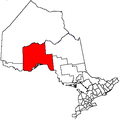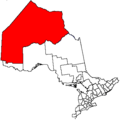Mishkeegogamang Ojibway Nation | |
|---|---|
First Nation | |
| Mishkeegogamang First Nation | |
| Coordinates: 51°14′06″N090°14′20″W / 51.23500°N 90.23889°W | |
| Country | Canada |
| Province | Ontario |
| Provincial Territorial Organization | Nishnawbe Aski Nation |
| District | Kenora |
| Government | |
| • Chief | Merle Loon |
| • Federal riding | Kenora—Kiiwetinoong |
| • Provincial riding | Kiiwetinoong |
| Area | |
• Total | 18,696.4 ha (46,199.8 acres) |
| Population | |
• Total | 2,100+ Registered Band Members |
| Postal Code | P0V 2H0 |
| Area code | 807 |
| Website | www.mishkeegogamang.ca |
Mishkeegogamang First Nation is an Ojibway band government (First Nation) in the Canadian province of Ontario. Until 1993, the band was called the Osnaburgh First Nation, with various settlements at times being called New Osnaburgh, Osnaburgh House, or Osnaburgh ("Oz" for short).
Contents
- Geography
- Infrastructure
- Transportation
- Medical centres and nearby hospitals
- Utilities
- Current Governance
- Chief and Council (2023-2025)
- First Nation Affiliations
- Official Address
- History
- Early history
- Osnaburgh House
- Twentieth and twenty-first century
- Elected Chiefs since 1905
- References
- External links
The traditional territory of the Mishkeegogamang Ojibway extends to the north, south, east and west, beyond the boundaries of Reserves 63A and 63B. The traditional territory is made up of the communities of the Main Reserve, Bottle Hill, Poplar Heights, Sandy Road, Doghole Bay, Rat Rapids, Cedar Rapids, Ten Houses, Eric Lake, Ace Lake, Metcalfe, Pashkokogan, Mile 50, Fitchie Lake, Mile 42, Mile 29, Menako Lakes, and the shores of Lake St. Joseph.
Mother Tongues: Ojibwe Anishinaabemowin, ᐊᓂᔑᓈᐯᒧᐎᓐ
It is located along Highway 599 in the Kenora District, approximately 20 km (12 mi) south of Pickle Lake. Its total registered population as of March 2022 is 2,028 (of which the on-reserve population was over 1,000 people as of the 2016 Census). At one time a member of the Windigo First Nations Council, Mishkeegogamang First Nation is not part of any regional tribal councils as of February 2015 [update] ; however, they have retained their membership with the Nishnawbe Aski Nation.




